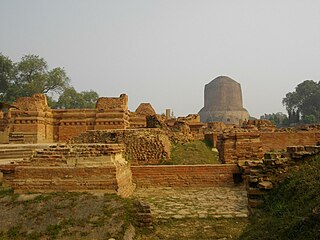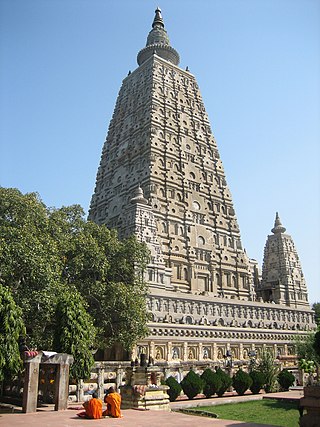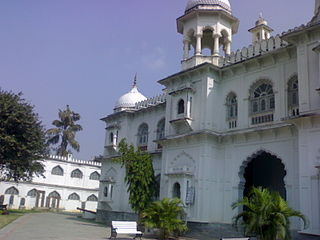Related Research Articles

The British Museum is a public museum dedicated to human history, art and culture located in the Bloomsbury area of London. Its permanent collection of eight million works is the largest in the world. It documents the story of human culture from its beginnings to the present. The British Museum was the first public national museum to cover all fields of knowledge.

Sarnath is a place located 10 kilometres northeast of Varanasi, near the confluence of the Ganges and the Varuna rivers in Uttar Pradesh, India.

The Mahabodhi Temple or the Mahābodhi Mahāvihāra, a UNESCO World Heritage Site, is an ancient, but rebuilt and restored Buddhist temple in Bodh Gaya, Bihar, India, marking the location where the Buddha is said to have attained enlightenment. Bodh Gaya is 15 km from Gaya and is about 96 km (60 mi) from Patna. The site contains a descendant of the Bodhi Tree under which the Buddha gained enlightenment, and has been a major pilgrimage destination of Buddhists for over two thousand years.

Sculpture in Japan began with the clay figure. Towards the end of the long Neolithic Jōmon period, some pottery vessels were "flame-rimmed" with extensions to the rim that can only be called sculptural, and very stylized pottery dogū figures were produced, many with the characteristic "snow-goggle" eyes. During the Kofun period of the 3rd to 6th century CE, haniwa terracotta figures of humans and animals in a simplistic style were erected outside important tombs. The arrival of Buddhism in the 6th century brought with it sophisticated traditions in sculpture, Chinese styles mediated via Korea. The 7th-century Hōryū-ji and its contents have survived more intact than any East Asian Buddhist temple of its date, with works including a Shaka Trinity of 623 in bronze, showing the historical Buddha flanked by two bodhisattvas and also the Guardian Kings of the Four Directions.

Bharhut is a village located in the Satna district of Madhya Pradesh, central India. It is known for its famous relics from a Buddhist stupa. What makes Bharhut panels unique is that each panel is explicitly labelled in Brahmi characters mentioning what the panel depicts. The major donor for the Bharhut stupa was King Dhanabhuti.

Buddhist art is visual art produced in the context of Buddhism. It includes depictions of Gautama Buddha and other Buddhas and bodhisattvas, notable Buddhist figures both historical and mythical, narrative scenes from their lives, mandalas, and physical objects associated with Buddhist practice, such as vajras, bells, stupas and Buddhist temple architecture. Buddhist art originated in the north of the Indian subcontinent, in modern India, Pakistan and Afghanistan, with the earliest survivals dating from a few centuries after the historical life of Siddhartha Gautama from the 6th to 5th century BCE.

Sculpture in the Indian subcontinent, partly because of the climate of the Indian subcontinent makes the long-term survival of organic materials difficult, essentially consists of sculpture of stone, metal or terracotta. It is clear there was a great deal of painting, and sculpture in wood and ivory, during these periods, but there are only a few survivals. The main Indian religions had all, after hesitant starts, developed the use of religious sculpture by around the start of the Common Era, and the use of stone was becoming increasingly widespread.

Telangana State Archaeology Museum or Hyderabad Museum is a museum located in Hyderabad, India. It is the oldest museum in Hyderabad.
Sripurandan (North) is a village in the Udayarpalayam taluk of Ariyalur district, Tamil Nadu, India.
Deepambalpuram is a village in the Papanasam taluk of Thanjavur district, Tamil Nadu, India.

Jain sculptures or Jain idols are the images depicting Tirthankaras. These images are worshiped by the followers of Jainism. The sculpture can depict any of the twenty-four tirthankaras with images depicting Parshvanatha, Rishabhanatha, or Mahāvīra being more popular. Jain sculptures are an example of Jain art. There is a long history of construction of Jain sculptures. Early examples include Lohanipur Torsos which has been regarded to be from the Maurya period, and images from the Kushan period from Mathura.

Veerasolapuram is an ancient village located near Kallakurichi in Kallakurichi district, Tamil Nadu, India.

Jain art refers to religious works of art associated with Jainism. Even though Jainism has spread only in some parts of India, it has made a significant contribution to Indian art and architecture.
Subhash Kapoor is an Indian American art smuggler who was convicted for running a $100 million international smuggling racket. He was previously the owner of the Art of the Past gallery in Manhattan. His sister business, Nimbus Import/Exports, specialised in selling antiquities from across the Indian Subcontinent and Southeast Asia to major museums around the world.
The Sripuranthan Natarajan Idol, is a 900-year-old statue of Natarajan — the dancing Shiva — that was stolen from the ancient Brihadeeswarar temple of Sripuranthan, smuggled to the United States, and then sold to the National Gallery of Australia, Canberra with a false provenance, for US$5.1 million. The statue was consequently returned by Australia to the Indian government on ethical grounds, once questions were raised on due diligence not being followed during the acquisition.

Jainism in Bihar trace a long history since the times of twenty-fourth Tirthankara Mahavira, who was born in Vaishali. The state of Bihar is considered to have played an important role in the development of Jainism.

The Kurkihar hoard is a set of 226 bronzes, mostly Buddhist, dating to between the 9th and 12th centuries CE, which were found in Kurkihar near Gaya in the Indian state of Bihar. The village of Kurkihar is situated about 5 km. north-east of Wazirganj, and 27 km east from Gaya. The inscriptions found suggest that Kurkihar was once a well known international pilgrimage center.

The Hansi hoard was discovered accidentally by children looking for a ball, when they discovered one of the images on January 19, 1982. Hansi is located in the Hisar district of Haryana state, India. Archaeological Survey of India then excavated the completely hoard in 1982. It contained 58 bronze images of Jain Tirthankaras inside Asigarh Fort dating back to the 8th—9th century, as determined by paleographical analysis, although none of the images are dated.

The Punnainallur Kailasanathar Temple, is a Hindu temple dedicated to Shiva located at Punnainallur near Thanjavur in the state of Tamil Nadu, India.
References
- ↑ "Facebook sleuths bring home India's stolen idols". The Business Times . 3 January 2017. Retrieved 5 January 2017.
- ↑ Ganapathy, Nirmala (10 November 2018). "Recovering India's stolen art pieces". The Straits Times . Retrieved 11 November 2018.
- ↑ On Independence Day, India gets back its 12th century stolen Buddha statue, Aditi Khanna, PTI, LiveMint, Aug 15 2018
- ↑ How the mystery of the Missing Buddha statue was solved, Bibek Bhattacharya, Aug 21 2018
- 1 2 Gopinathan, Sharanya (7 September 2021). "Meet the Amateur Art Sleuths Fighting To Bring Back India's Looted Cultural Heritage". Vice. Retrieved 21 May 2023.